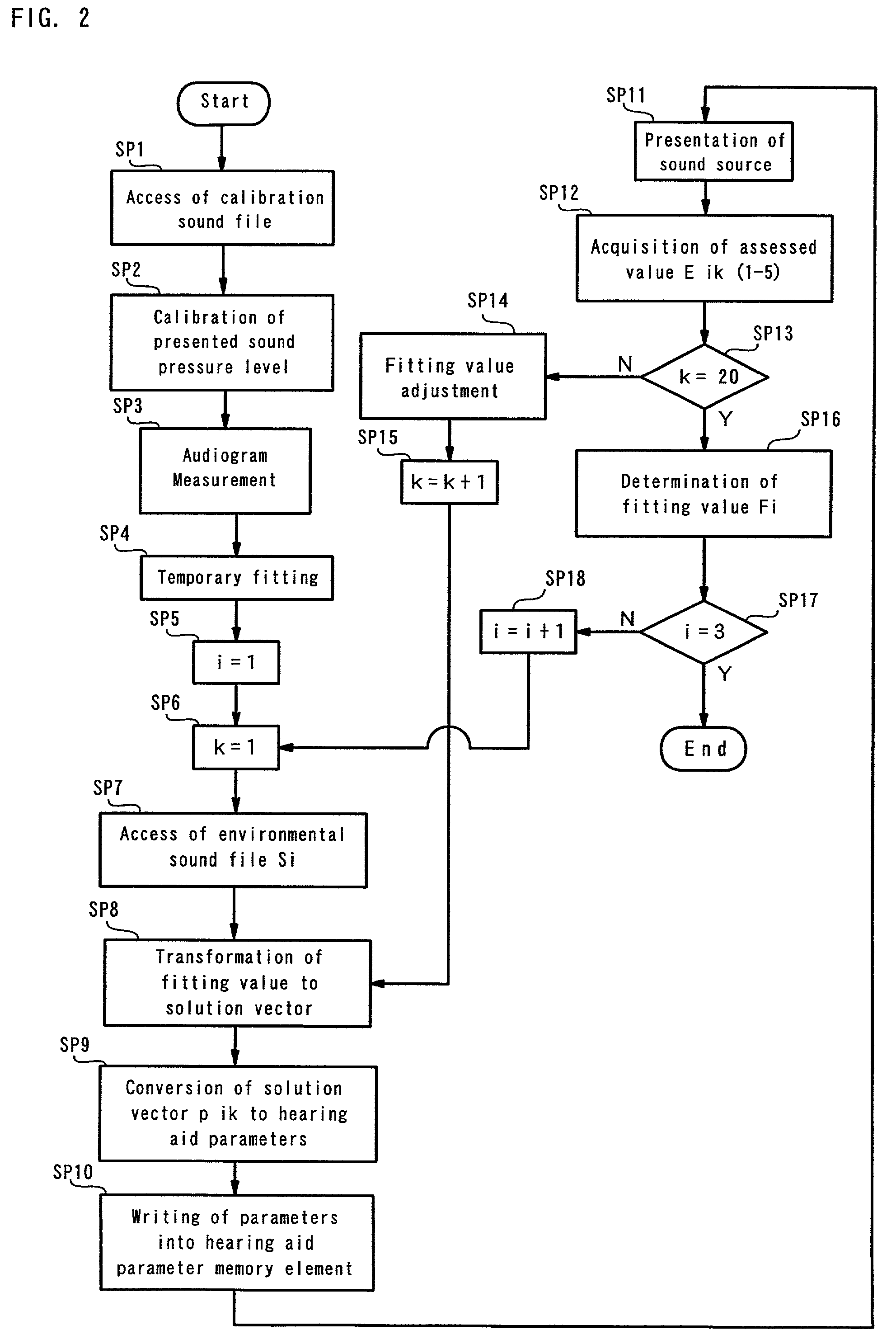Optimum solution method, hearing aid fitting apparatus utilizing the optimum solution method, and system optimization adjusting method and apparatus
a technology of optimum solution and optimum solution, applied in the field of hearing, can solve the problems of difficult to determine the optimum adjustment, the adjustment result cannot be evaluated and expressed quantitatively, and the evaluation criteria of these characteristics are extremely subjective and unclear, so as to find and the optimum solution efficiently and correctly by minimizing the fluctuations in the evaluation
- Summary
- Abstract
- Description
- Claims
- Application Information
AI Technical Summary
Benefits of technology
Problems solved by technology
Method used
Image
Examples
first embodiment
[0075]A hearing aid fitting apparatus according to the present invention comprises, as shown in FIG. 1, a sound source processing element 1, a parameter production element 2, and a two-dimensional space displaying element 3. Reference numeral 4 is a so-called programmable hearing aid, and reference numeral 6 is a speaker for presenting a speech sound, an environmental sound, and the like, to the programmable hearing aid 4.
[0076]The sound source processing element 1 consists of a sound source memory element 1a, a sound source signal converting element 1b, a sound source signal selecting element 1c, and a sound source presenting element 1d. The parameter production element 2 consists of a coordinate acquisition element 2a, a solution vector computing element 2b, and a parameter writing element 2c. The two-dimensional space displaying element 3 consists of an optimum solution vector acquiring element 3a, a two-dimensional coordinate computing element 3b, and a display element 3c.
[0077...
second embodiment
[0126]A hearing aid fitting apparatus according to the present invention has the same construction as in FIG. 1 and therefore further explanation is omitted.
[0127]An operation of the hearing aid fitting apparatus according to the second embodiment will now be described. A method for determining a final fitting value is shown in a flow chart of FIG. 7, using the optimum fitting values F1, F2, and F3 for the three types of sound sources S1, S2, and S3 and the value Eik for various fitting values which are found by the flow chart as shown in FIG. 2.
[0128]First, in step SP 61, the optimum fitting values F1, F2, and F3 obtained by the method shown in FIG. 2 are acquired at the optimum solution vector acquiring element 3a, and each of Euclidean distance d12, d13, and d23 between the optimum fitting values F1, F2, and F3 is computed.
[0129]In step SP 62, a triangle, the sides of which are the Euclidean distances d12, d13, and d23 long, is presumed by the two-dimensional coordinate computing...
third embodiment
[0161]Next, a hearing aid fitting apparatus according to the present invention, as shown in FIG. 11, comprises an acoustic information presenting element 11 and a parameter production element 12. As the same reference numerals are used as those shown in FIG. 1, further explanation is omitted because they have the same contents.
[0162]The acoustic information presenting element 11 is composed of a sound source memory element 11a, a sound source signal converting element 11b, a sound source signal selecting element 11c, and a sound source presenting element 11d. The parameter production element 12 is composed of a solution vector expressing element 12a, a solution vector set generating element 12b, a parameter writing element 12c, and an evaluation value acquiring element 12d.
[0163]The sound source memory element 11a stores a file in which a sound source (acoustic information) used in the fitting operation is digitally recorded and a calibration sound file. The sound source and calibr...
PUM
 Login to View More
Login to View More Abstract
Description
Claims
Application Information
 Login to View More
Login to View More - R&D
- Intellectual Property
- Life Sciences
- Materials
- Tech Scout
- Unparalleled Data Quality
- Higher Quality Content
- 60% Fewer Hallucinations
Browse by: Latest US Patents, China's latest patents, Technical Efficacy Thesaurus, Application Domain, Technology Topic, Popular Technical Reports.
© 2025 PatSnap. All rights reserved.Legal|Privacy policy|Modern Slavery Act Transparency Statement|Sitemap|About US| Contact US: help@patsnap.com



